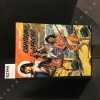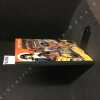-
Type
Any type (1)
Book (1430)
Disk (1)
Engraving (1)
Magazine (16)
Music sheets (13)
New book (1)
Posters (1)
-
Latest
Last 24h (1)
Last 3 days (1)
Last month (22)
Last week (1)
-
Language
English (14)
French (1450)
-
Century
18th (1)
19th (4)
20th (601)
21st (178)
-
Countries
Belgium (220)
Canada (1)
China (1)
Denmark (1)
France (1214)
Netherlands (3)
Switzerland (24)
-
Syndicate
ALAC (1)
CLAM (4)
ILAB (245)
SLAM (238)
HISTOIRES DU FAR WEST
TCHOU. 1967. In-4. Relié. Bon état, Couv. convenable, Dos satisfaisant, Intérieur frais. 728 pages - nombreuses illustrations photos et cartes noir et blanc dans et/ou hors texte - annotations au crayon dans le texte - signet - + 4 coupures de presse relatives au thème de l'ouvrage. . . . Classification Dewey : 791.4362-Western
Classification Dewey : 791.4362-Western
Histoires et Légendes du Far West
TCHOU. 3 nov. 1969. In-8. Cartonnage d'éditeurs. Bon état, Couv. fraîche, Dos satisfaisant, Intérieur frais. 276 pages. Nombreuses illustrations et photos en noir et blanc, dans le texte et hors-texte.. . . . Classification Dewey : 791.4362-Western
"Collection ""Histoires et Légendes Noires"". Classification Dewey : 791.4362-Western"
La véritable conquête de l'Ouest américain.
Paris, Tchou, 1970. 24 x 32, sans pagination, très nombreuses illustrations en N/B, reliure d'édition carton imprimé, bon état.
préface d'Yves Berger.
"Les Fils du soleil; tome 1 : Les siècles de la liberté, de la préhistoire au XVIe siècle."
Paris, Seuil, 1978. 20 x 28, 219 pp., très nombreuses illustrations en couleurs et en N/B, plusieurs dessins, broché, bon état.
Enquêtes photographiques de Michel Rieupeyrout et Jean-Robert Masson.
SHERIFS ET HORS LA LOI, L'OUEST VRAI .
Editions Gallimard, Paris 1973, collection "1000 soleils", illustrations, photos, cartonnage éditeur avec sa jaquette illustrée, 190pp. très bon état, 210x130 . (p3)
Exemplaire avec dédicace autographe de l'Auteur .
Phone number : 33 05 49 26 70 36
Shérifs et hors-la-loi, l'Ouest vrai.
Couverture rigide. Reliure de l'éditeur. 187 pages. Jaquette légèrement défraîchie. Cachet sur la page de titre.
Livre. Editions Gallimard (Collection : 1000 soleils), 1977.
Augustine: Ancient Thought Baptized
Cambridge University Press 2008 356 pages 15 2x2 6x22 6cm. 2008. Broché. 356 pages.
Bon Etat tranche un peu ternie intérieur propre bonne tenue
Rizzacasa A. Marcoaldi Giovanni Battista Giacomo da Viterbo
Reference : 100132876
(1994)
Il governo della Chiesa (Biblioteca medievale)
Nardini 1994 432 pages in8. 1994. Broché. 432 pages.
Très Bon Etat intérieur frais bonne tenue
Capitaine Apache. Intégrale. Tome 1.
2018 Editions du Taupinambour - 2018 - In-quarto, cartonnage illustré - 85 planches en couleurs
Très bon état - Très bon
destruction de Sodome et de Gomorrhe (Gn 18-19) dans la litt rature chr tienne des premiers si cles
, Brepols, 2019 Paperback, 223 pages, Size:148 x 210 mm, Languages: French, Italian, English. ISBN 9782503581767.
Summary Situ entre l'alliance avec Abraham et la naissance d'Isaac, l'histoire de la destruction de Sodome et de Gomorrhe (Gn 18-19) a marqu l'imaginaire juif et chr tien. Le pr sent volume tudie la fa on dont il a t interpr t et r crit dans les cinq premiers si cles de notre re. Agn s Bastit-Kalinowska analyse les t moignages bibliques et patristiques des trois premiers si cles sur ce r cit. Sergio Zincone tudie ensuite l'ex g se que Jean Chrysostome en a donn e, tandis que Rachel Toone discute l'utilisation pol mique qu'il en faite dans le trait Contre les opposants la vie monastique. Avec R gis Courtray, c'est l' x g se occidentale des IVe-Ve si cles qui est analys e. Marie-Pierre Buissi re poursuit par une pr sentation de l'ex g se de l'Ambrosiaster, o il est question du sort des b b s de Sodome. La seconde section examine la grande post rit que ce r cit a eue dans la po sie latine des IVe-Ve si cle. Aline Canellis propose une relecture du Carmen de Sodoma, dont elle donne la premi re traduction fran aise. Michele Cutino tudie la fa on dont Claudius Marius Victorinus r crit le r crit de la destruction de Sodome dans son Alethia. Laurence Gosserez analyse enfin la r criture qu'en propose l'Harmatig nie de Prudence. TABLE OF CONTENTS Agn s Bastit, La destruction de Sodome et Gomorrhe (Gn 18-19) et sa r ception aux trois premiers si cles Sergio Zincone, I frutti guasti di Sodoma e la sua distruzione : l'esegesi di Giovanni Crisostomo Rachel Toone, Redeeming the City: A Study of Book III of Chrysostom's Against the Opponents of the Monastic Life R gis Courtray, La destruction de Sodome chez Ambroise, J r me et Augustin Marie-Pierre Bussi res, Quel sort pour les b b s de Sodome ? La contamination du p ch ou le m rite individuel chez l'Ambrosiaster Aline Canellis, Relecture du Carmen de Sodoma [CPL 1425] : Probl mes d' tablissement du texte et de traduction Michele Cutino, La r criture de la destruction de Sodome dans l'Alethia de Claudius Marius Victorinus Laurence Gosserez, La destruction de Sodome dans l'Hamartig nie de Prudence (H., 723-776) Index
The Swedish Imperial Experience 1560-1718
Cambridge University Press 1979 172 pages in8. 1979. Broché. 172 pages.
Bon Etat couverture jaunie intérieur propre
The Age of Liberty: Sweden 1719-1772
Cambridge University Press 1986 244 pages in8. 1986. Cartonné jaquette. 244 pages.
Bon état avec sa jaquette intérieur propre
Festivals and Legends: Formation of Greek Cities in the Light of Public Ritual: The Formation of Greek Cities in the Light of Public Ritual (PHOENIX SUPPLEMENTARY VOLUME)
University of toronto press 1993 336 pages 15 4x3x23 2cm. 1993. Cartonné. 336 pages.
Très bon état intérieur propre bonne tenue
Terror of Oklahoma (Western)
Editions de l'amicale/Librairie Théâtrale. 1971. In-12. Broché. Etat d'usage, Couv. légèrement passée, Agrafes rouillées, Quelques rousseurs. 24 pages.. . . . Classification Dewey : 791.4362-Western
Classification Dewey : 791.4362-Western
L'impossibile volere. Tommaso d'Aquino i tomisti e la volontà
Vita e pensiero 2025 268 pages in8. 2025. Broché. 268 pages.
proche du neuf
- Robin Leo,Hollander Frederick - Robin Leo,Hollander Frederick
Reference : 26180
(1936)
Partition de la chanson : House Jack Built for Jill (The) Bing Crosby - France Farmer - Bob Burns Rythm on the range
Famous Music Corporation 1936
Bon état Grand format Piano
The Sources of Roman Law: Problems and Methods for Ancient Historians (Approaching the Ancient World)
Routledge 1996 168 pages in8. 1996. Broché. 168 pages.
Très bon état bonne tenue intérieur propre
Rodeo n°54
1956 Editions LUG - N° 54 - 02/1956 - In-12, broché, couverture illustrée - 132 planches en N&B
Très bon état, état exceptionnel pour un collectionneur - Infimes rousseurs sur la couverture, la 1ère et la dernière page - Petits accrocs aux extrémités du dos - Un coin très légèrement corné
Rodeo n°56
1956 Editions LUG - N° 56 - 04/1956 - In-12, broché, couverture illustrée - 128 planches en N&B
Très bon état, état exceptionnel pour un collectionneur - Dos légèrement fragilisé au niveau des agrafes - Infimes rousseurs au niveau du dos
Rodeo n°58
1956 Editions LUG - N° 58 - 06/1956 - In-12, broché, couverture illustrée - 128 planches en N&B
Très bon état, état exceptionnel pour un collectionneur - Très légers frottements et petites rousseurs sur la couverture
Rodeo n°59
1956 Editions LUG - N° 59 - 07/1956 - In-12, broché, couverture illustrée - 128 planches en N&B
Très bon état, état exceptionnel pour un collectionneur - Discrètes rousseurs sur la couverture - Dos fragilisé au niveau des agrafes - Premières pages mal massicotées
Rodeo n°60
1956 Editions LUG - N° 60 - 08/1956 - In-12, broché, couverture illustrée - 128 planches en N&B
Très bon état, état exceptionnel pour un collectionneur
Rodeo n°62
1956 Editions LUG - N° 62 - 10/1956 - In-12, broché, couverture illustrée - 128 planches en N&B
Très bon état, état exceptionnel pour un collectionneur - Dos très légèrement voilé et fragilisé au niveau du dos - Légères rousseurs sur la 1ère et la dernière page
Rodeo n°63
1956 Editions LUG - N° 63 - 11/1956 - In-12, broché, couverture illustrée - 128 planches en N&B
Très bon état, état exceptionnel pour un collectionneur - Dos très légèrement voilé - Discrètes rousseurs sur la 1ère de couverture - Menus frottements sur la 4ème de couverture
Rodeo n°66
1957 Editions LUG - N° 66 - 02/1957 - In-12, broché, couverture illustrée - 128 planches en N&B
Très bon état, état exceptionnel pour un collectionneur - Infimes rousseurs sur la couverture
 Write to the booksellers
Write to the booksellers



























